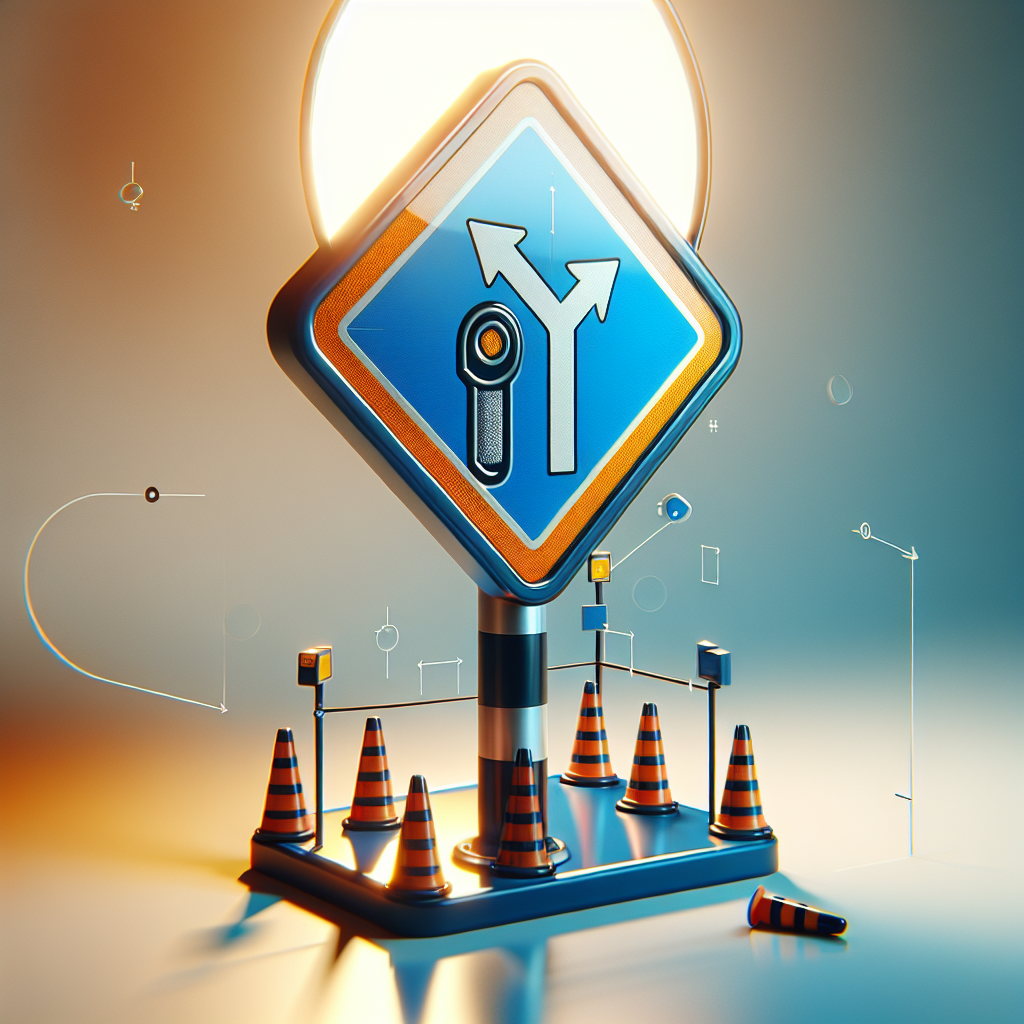
In this article, we will explore the importance of maintaining road safety accessories. As a responsible driver, it is crucial that you understand the significance of these accessories and how their proper upkeep can contribute to overall road safety. From reflective road signs to speed bumps and guardrails, every component plays a vital role in ensuring the well-being of drivers, pedestrians, and cyclists alike. By prioritizing regular maintenance and inspections, you are not only safeguarding yourself but also contributing to the overall safety of the community. Let’s delve into the reasons why maintenance of road safety accessories should never be overlooked.
Signboards
Cleaning
Regular cleaning of signboards is essential to ensure their visibility and effectiveness. You should clean signboards at regular intervals, removing dirt, dust, and any other debris that may accumulate on them. Use a mild detergent and a soft cloth or sponge to gently clean the signboards, avoiding any harsh chemicals that may damage the surface or the text on the sign.
Repairing and replacement
Inspect signboards for any damages, such as cracks, chips, or fading. If you notice any damage, it is important to repair or replace the signboard promptly. This will help maintain the clarity and legibility of the sign, ensuring that it effectively communicates the intended message to drivers and pedestrians. Be sure to use the appropriate materials and techniques for repair or replacement to ensure the signboard’s durability and longevity.
Visibility check
Regularly check the visibility of signboards to ensure that they are easily visible to motorists and pedestrians. Factors such as overgrown vegetation, obstructions, or improper placement can hinder the visibility of signboards. Ensure that signboards are positioned at an appropriate height and angle for maximum visibility. Clear any vegetation or obstructions that may obstruct the view of the sign. It is important to prioritize visibility to ensure that signboards effectively contribute to road safety.
Road Markings
Repainting
Over time, road markings can fade due to weather conditions and regular wear and tear. It is crucial to repaint road markings to maintain their visibility and ensure that motorists can clearly understand and follow the intended traffic flow. Repaint road markings using high-quality paint and follow the appropriate guidelines for colors, dimensions, and spacing to ensure consistency and compliance with regulatory standards.
Reflectivity check
Reflectivity plays a vital role in the visibility of road markings, especially during nighttime or adverse weather conditions. Regularly check the reflectivity of road markings to ensure that they are adequately reflective and visible to drivers. Use appropriate equipment, such as retroreflectometers, to measure the reflectivity levels. If the reflectivity is below the required standards, consider applying reflective materials or repainting with reflective paint to enhance visibility and road safety.
Removal of faded markings
Faded road markings can cause confusion and compromise road safety. Identify and remove any faded or irrelevant markings to avoid confusion among road users. Faded markings should be completely removed or covered to prevent confusion with new or updated road markings. Ensure that the removal process is carried out safely, and the road surface is properly prepared for the application of new markings.
Traffic Signals
Cleaning
Regularly clean traffic signals to maintain their visibility and ensure that they are easily visible to motorists from a distance. Use a gentle cleaning solution and a soft cloth to clean the lenses and casing of the traffic signals. Avoid using abrasive materials or harsh chemicals that may damage the signals or impair their functionality. Regular cleaning helps remove dirt, dust, and any other obstructions that may hinder the visibility of the signals.
Functionality check
Periodically inspect the functionality of traffic signals to ensure that they are operating correctly. Check for any flickering lights, erratic timing, or malfunctioning components. Conduct a thorough inspection of the wiring, bulbs, and control systems to identify any issues that may affect the proper functioning of the traffic signals. Promptly address any malfunctions to minimize disruptions in traffic flow and ensure road user safety.
Replacement of bulbs
Regularly check the condition of bulbs in traffic signals and replace any damaged or burnt-out bulbs promptly. Dim or non-functioning bulbs can significantly reduce the visibility of traffic signals, leading to confusion and potential accidents. Follow the manufacturer’s recommendations for bulb replacements and ensure that the new bulbs meet the required specifications for brightness and color.
Traffic Signs
Cleaning
Clean traffic signs regularly to maintain their visibility and legibility. Use a mild detergent and a soft cloth to remove dirt, dust, and any other debris from the sign surfaces. Avoid using abrasive materials or harsh chemicals that may damage the signs or affect the reflective properties. Regular cleaning helps ensure that traffic signs effectively communicate important information to road users.
Replacement of damaged signs
Inspect traffic signs for any damages, such as cracks, bends, or missing portions. Damaged signs should be promptly replaced to ensure accurate and clear communication with road users. Use appropriate materials and techniques for sign replacement, ensuring that the new signs meet regulatory standards and are positioned correctly for maximum visibility.
Visibility check
Regularly check the visibility of traffic signs to ensure that they are easily readable and recognizable from a distance. Factors such as foliage, obstructions, or improper positioning can hinder the visibility of signs. Trim or remove any vegetation that obstructs the view of the signs and ensure that signs are positioned at an appropriate height and angle for optimal visibility. Prioritize visibility to enhance road safety and prevent confusion among road users.
Speed Bumps
Cleaning
Regularly clean speed bumps to maintain their visibility and functionality. Remove dirt, debris, and any other obstructions that may accumulate on the speed bump surface. Use a broom or a pressure washer to effectively clean the speed bump while avoiding any damage to its structure. A clean and well-maintained speed bump ensures that motorists are aware of its presence and can safely navigate their vehicles.
Repairing
Inspect speed bumps for any damages, such as cracks, breaks, or uneven surfaces. Promptly repair any damages to prevent further deterioration and maintain the effectiveness of the speed bump. Use appropriate materials and techniques for repairs, ensuring that the speed bump remains structurally sound and safe for use by vehicles of all sizes.
Reflectivity check
Regularly check the reflectivity of speed bumps, especially during nighttime or low light conditions. Adequate reflectivity helps improve the visibility of speed bumps, alerting drivers to their presence and ensuring safer driving conditions. Use retroreflectometers or similar devices to measure the reflectivity levels. If the reflectivity is below the required standards, consider applying reflective materials to enhance visibility and road safety.
Guardrails
Cleaning
Regularly clean guardrails to remove dirt, debris, and vegetation that may accumulate and obstruct the view of the guardrail. Use a soft cloth, brush, or pressure washer to effectively clean the guardrail while avoiding any damage to its structure. A clean guardrail helps enhance visibility and ensures that it provides effective protection to road users.
Inspection for damage
Periodically inspect guardrails for any damages, such as dents, bends, or loose components. Damaged guardrails should be promptly repaired or replaced to maintain their structural integrity and effectiveness. Thoroughly inspect the entire length of the guardrail to identify any potential safety hazards and prioritize repairs to ensure road user safety.
Repairing and replacement
Repair or replace damaged guardrails promptly to prevent further deterioration and ensure their proper functionality. Use appropriate materials and techniques for repairs or replacement, following regulatory standards and guidelines. Guardrails are essential safety features that protect drivers and passengers in the event of a collision, so it is crucial to maintain them in good condition to fulfill their intended purpose.
Reflectors
Cleaning
Regularly clean reflectors to remove dirt, grime, and other substances that may hinder their reflectivity. Use a soft cloth or brush to gently clean the reflectors, avoiding any harsh chemicals that may damage the reflective surfaces. Clean reflectors help enhance visibility, especially during nighttime or adverse weather conditions, contributing to overall road safety.
Replacement of damaged reflectors
Inspect reflectors for any damages, such as cracks, chips, or missing portions. Damaged reflectors should be promptly replaced to ensure optimal reflectivity and visibility. Use appropriate materials and techniques for replacement, ensuring that the new reflectors meet the required specifications for brightness and durability.
Visibility check
Regularly check the visibility of reflectors to ensure that they effectively reflect light, making them easily visible to motorists. Adequate reflectivity helps drivers identify lane markings, curves, or other important features on the road. Check reflectors during different lighting conditions to ensure their performance across various scenarios. Pay close attention to areas where reflectors are commonly damaged, such as intersections or curves, and prioritize their maintenance accordingly.
Street Lighting

Cleaning
Regularly clean street lighting fixtures, including lamps and covers, to maintain their efficiency and visibility. Remove dirt, dust, and any other obstructions that may accumulate on the surfaces of the lighting fixtures. Use a soft cloth or brush to gently clean the fixtures, avoiding any harsh chemicals that may damage the components. Clean street lighting ensures that roads and pedestrian areas are adequately illuminated, enhancing safety for all road users.
Replacement of faulty bulbs
Regularly check the condition of bulbs in street lighting fixtures and promptly replace any faulty or burnt-out bulbs. Dim or non-functioning bulbs can create dark spots on the roads, compromising visibility and increasing the risk of accidents. Follow the manufacturer’s recommendations for bulb replacements, ensuring that the new bulbs meet the required specifications for brightness and energy efficiency.
Maintenance of electrical connections
Periodically inspect the electrical connections of street lighting fixtures to ensure their proper functioning. Loose or damaged connections can lead to unreliable lighting and potential hazards. Conduct a thorough inspection of the wiring, sockets, and control systems, addressing any issues promptly to prevent disruptions in the street lighting system. Regular maintenance of electrical connections helps ensure consistent and reliable street lighting, contributing to safer road conditions.
Pedestrian Crossings
Cleaning
Regularly clean pedestrian crossings to ensure their visibility and legibility. Use a mild detergent and a soft brush or cloth to remove dirt, grime, and any other debris from the surface of the crossings. Pay special attention to the markings and signage, as well as the visibility of any accessible signals for pedestrians. Clean pedestrian crossings contribute to safer pedestrian experiences and facilitate smooth traffic flow.
Repainting
Over time, pedestrian crossings can fade or wear out due to heavy usage or exposure to weather conditions. Repainting pedestrian crossings is crucial to maintain their visibility and ensure that motorists can clearly identify and yield to pedestrians. Use appropriate paint and follow the regulatory standards for colors, dimensions, and placement to ensure consistency and compliance. Well-marked pedestrian crossings create a safer environment for both pedestrians and motorists.
Installation of accessible signals
Consider installing accessible signals at pedestrian crossings to enhance safety and inclusivity for individuals with visual impairments. Accessible signals provide audible cues or tactile vibrations to alert pedestrians when it is safe to cross. Install these signals in accordance with accessibility guidelines, ensuring that they are properly positioned and functioning correctly. Improving the accessibility of pedestrian crossings promotes a more inclusive and safer road environment for everyone.
CCTV Cameras
Cleaning
Regularly clean CCTV cameras to maintain their effectiveness and ensure clear video footage. Use a soft cloth or brush to gently remove dirt, dust, or cobwebs that may accumulate on the camera lenses. Clean the camera housing and any other components to prevent any obstruction that may affect the camera’s performance. Clean CCTV cameras help ensure reliable surveillance and capture of important events on the road.
Checking angles and focus
Periodically check the angles of CCTV cameras to ensure they are properly positioned to capture the desired areas. Adjust the camera angles as necessary to provide optimal coverage and maximize the effectiveness of the surveillance system. Additionally, ensure that the camera focus is adjusted correctly to capture clear and focused video footage. Regular checks and adjustments help maintain the accuracy and efficiency of the CCTV cameras.
Maintenance of recording systems
Maintain the recording systems of CCTV cameras to ensure continuous operation and reliable storage of video footage. Regularly check the storage capacity, backup mechanisms, and connectivity of the recording systems. Perform routine maintenance tasks, such as software updates or hard drive replacements, to keep the recording systems operating at their best. A well-maintained recording system ensures that valuable video footage is properly stored and can be used for investigations or traffic analysis.
In conclusion, the maintenance of road safety accessories is crucial to ensure their effectiveness in promoting road safety for all road users. Regular cleaning, repairing, and replacement of these accessories, such as signboards, road markings, traffic signals, traffic signs, speed bumps, guardrails, reflectors, street lighting, pedestrian crossings, and CCTV cameras, help to maintain their visibility, functionality, and performance. By prioritizing the maintenance of road safety accessories, we can contribute to safer roads, reduced accidents, and an improved overall road experience. Stay proactive in the maintenance of road safety accessories and make road safety a priority for a safer and more efficient transportation system.









